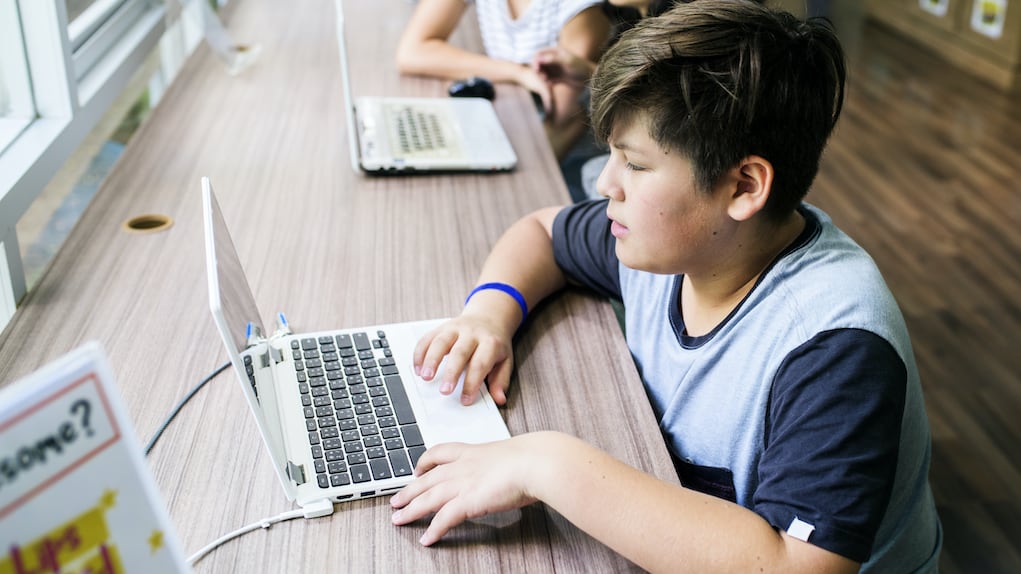5 Research-Based Recommendations for Remote Learning: Lessons from LUSD

The 2020 COVID-19 pandemic forced the largest school closure in modern American history. Between March and June, nearly every district in the country shut down, forcing over 55 million students into remote learning. Since little research existed to guide schools as they shifted to this new instruction, the Center on Reinventing Public Education (CRPE) launched a study that tracked a nationally representative sample of 477 K-12 districts.
The researchers found that while approximately 85% of districts offered some form of remote instruction, two-thirds of those districts set low expectations, only half tracked their students’ engagement, and a mere 42% required educators to provide regular feedback. Further, rural and high poverty districts reported less synchronous interaction, lower expectations, and minimal requirements to connect with students. These numbers can seem discouraging, but consider what remote instruction might look like in a rural, high-poverty district that set personalized expectations for each student, monitored their growth and engagement, and not only encouraged ongoing feedback but also stressed the need for educators to maintain a safe and supportive learning community.
Lindsay Unified School District (LUSD)—located in a rural, central California district—serves a low socioeconomic, largely Hispanic/Latino community and did just that. Given its focus on equity, lifelong learning, and personalized support, LUSD possessed the ideal conditions for successful remote learning. Therefore, to better understand their learners’ experience this spring, the district partnered with The Learning Accelerator (TLA) to conduct a mixed-methods study of educator perceptions and observations.
An online survey collected data from 144 LUSD educators (response rate of 70%). Multiple-choice questions asked educators to report the frequency of observed learner actions, and open-response prompts allowed them to describe the learners’ experiences. The analysis revealed five trends to inform future considerations for the coming school year.
1. Focus on Building Community.
Over 87% of the educators noted that their learners frequently felt safe, cared for, and supported in their learning environments. Prior to the COVID closure, district leaders had communicated that maintaining a sense of community would remain a priority. From reading “social stories” to holding virtual dance parties to creating space for learners to socialize with their peers, educators designed experiences to build a sense of connectedness.
With the transition to a new school year when students will have new classmates and new educators, these opportunities will be critically important. In addition to the normal challenges associated with transitions, there will most likely be masks, social distancing, and frequent hand washing as well as missing high-fives, fist-bumps, and hugs. Educators and leaders will need to carefully consider how they create a sense of community that makes students feel safe, comfortable, and connected in school and in a remote context.
2. Address Challenges of Goal Setting and Progress Monitoring.
When explicitly asked whether learners had made progress or persevered towards their goals, ALL of the high school educators indicated that their learners had always, often, or sometimes been able to do so, yet with younger students, fewer than 16% reported that this occurred. However, as one middle school educator wrote, “Any day that [the students] turn on their computer is progress towards their meaningful short and long term goals.”
Similarly, educators indicated that a relatively low percentage of learners continued to monitor their progress during remote instruction. As a high school educator explained, in a remote learning context, learners required even more “prods, pokes, and pushes.” Therefore, leaders should encourage educators to scaffold these skills with direct instruction, routines to help students self-monitor, data to support student reflection, strategies for goal setting—especially with young learners—and even working directly with parents or family members to ensure that students have sufficient support when learning remotely.
3. Manage the Tension Between Choice and Clarity.
Student choice drives LUSD’s personalized learning model; and yet, when asked how often learners chose their activities or tasks during remote instruction, educators noted varying frequencies depending on the age of their students. At the high school, over 40% of educators indicated that their students always or often chose their tasks and activities, but 24.1% of PK-2 educators reported that this rarely or never occurred.
Interestingly, over 50% of the LUSD faculty described how they gave their learners choice when responding to the open-response prompt. Several discussed the use of “choice boards,” and even more remarked that much of the choice lay in when or whether students might complete a task. Particularly at the elementary level, educators wrote that their learners needed more structure as too much choice became overwhelming. In the fall, teachers and leaders will need to explicitly acknowledge and address this balance between student agency and managing ambiguity.
4. Consider the Balance of Technology.
On the one hand, LUSD educators reported that their learners leveraged technology to explain their thinking, share their problem solving, and maintain social connections. Digital tools also created opportunities for student choice as well as differentiation. On the other hand, multiple educators mentioned the need to ensure greater familiarity with core tools and apps for themselves and their learners.
Additionally, over 50% of the open-response comments pertaining to questions about academic rigor included direct mention of specific technologies absent and larger discussion about how the learners might have used those tools. Considered through the lens of the Teaching for Understanding with Technology framework, this could intimate that educators need additional support when it comes to designing instruction with digital tools. With increased remote, blended, and hybrid learning, this tension will need to be continuously monitored and addressed with professional learning as well as ongoing support.
It is important to note that LUSD completed a Community Wi-Fi Project in 2015 to provide free, filtered Internet access to all learners. They also had enough school-issued devices to fully support online learning. However, this is not always the case. A recent report from Common Sense Media found that 37% of rural students lack adequate technology access to fully engage in remote learning. Leaders and educators will need to monitor whether students have access to both sufficient internet and an adequate device so that they can adapt instruction and resourcing to meet their students’ needs.
5. Sustain Momentum and Support.
Finally, as districts prepare for the next round of remote learning, sustaining momentum may become more of a challenge. In LUSD, many educators noted that their learners’ effort and energy waned towards the end of the school year. Further, educators felt stressed after weeks of going above and beyond to build home-school connections.
Despite herculean efforts, only 1.69% of LUSD educators had daily contact with ALL of their learners. In reality, they connected with anywhere from 20-50% each day. More concerning, almost half of the educators indicated that they had not been able to connect at all with 1-20% of their learners. This creates concern not only about reaching those missing learners but also sustaining momentum with educators who continually try to maintain contact.
Leaders must consider ways to provide clear expectations for contact as well as strategies and social emotional support for both their educators and their students before the next shift to remote learning. The research also speaks to the need for broader support for students, their families, and educators in the coming school year.
The national data paints a bleak picture of remote learning, especially in low-income and rural communities: low expectations, little engagement, and minimal regular feedback. However, in LUSD, over 60% of the educators reported that their learners received feedback at least 3-4 times per week and more than 87% noted that their learners felt cared for on a regular basis. As LUSD prepares for the next school year, they can expand on these successes to make future improvements. The nation’s districts may also leverage these findings to establish more holistic supports for students in the fall.
For more, see:
- Defining and Measuring the ‘Personal’ in Personalized Learning
- Remote Learning: Lessons Learned and Reflections to Inform the Future
- EdTech Report: Key Findings in Response to Remote Learning
Stay in-the-know with innovations in learning by signing up for the weekly Smart Update.
We know that educators and leaders have spent the last couple of months scrambling to meet the immediate needs of learners in their community. Thank you to each and every one of you for everything you’ve done to make the best out of this challenging situation. Now that the end of the school year is here, we’re shifting our Getting Through series from stories and advice to support remote learning or long term closures, to getting ready for the complex work of reopening schools this fall.
Interested in contributing to this campaign?
Email your stories and ideas to [email protected] or tweet using #GettingThrough to participate!







0 Comments
Leave a Comment
Your email address will not be published. All fields are required.